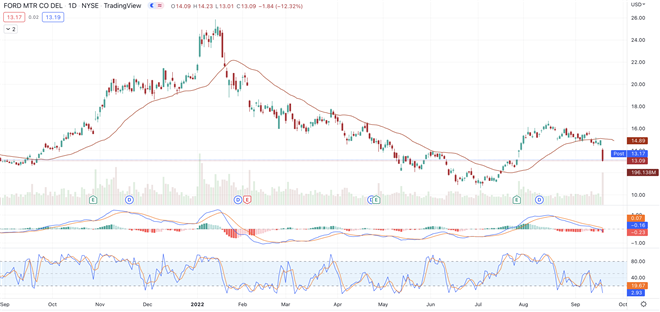
- Ford reiterated its full-year earnings guidance
- Ford expects to have about 40,000 to 45,000 vehicles in inventory at the end of the third quarter
- Ford's current rating is “hold,” with a price target of $18.28
Ford (NYSE: F) crashed big on Tuesday, dropping more than 12% in triple average volume, ending the session at $13.09.
It was the stock’s worst day in 11 years, and followed the company’s pre-earnings warning that it had incurred $1 billion in unanticipated supply-chain-related costs. Inflation also played a role.
Prior to the release, shares had been struggling. Like many other stocks, as well as the broader market, Ford attempted a rally over the summer, but it fizzled in August. Even with Tuesday’s collapse, shares remained above their previous structure low of $10.61, reached on July 5.
Ford said it expects to have about 40,000 to 45,000 vehicles in inventory at the end of the third quarter lacking certain parts currently in short supply. Those parts disproportionately include high-demand, high-margin models of popular trucks and SUVs.
The company advised that completing these vehicles will shift some revenue and earnings before interest and taxes to the fourth quarter. The company now expects the current quarter’s third-quarter adjusted EBIT to fall in a range between $1.4 billion and $1.7 billion.
Even so, Ford reiterated its full-year earnings guidance. However, Wall Street didn’t let the company off the hook for the immediate future, at least in terms of price action.
Ford Price Target Unchanged
According to MarketBeat price target data, no analysts lowered their target on Ford following the announcement. The current rating is “hold,” with a price target of $18.28, a potential upside of 39.68%.
How realistic is that, given this quarter’s shortfall?
The affirmation of the full-year guidance is a possible signal that the company is confident about its ability to sell the unfinished vehicles in the fourth quarter.
Nonetheless, the broad market dropped Tuesday. Even if Ford rekindled supply-chain concerns, which most analysts had believed were easing, there’s still room for worry about the Fed’s interest-rate hikes.
In addition, some analysts believed Ford was getting through the well-documented semiconductor shortages better than others in its industry.
It’s possible shares will continue falling if Wall Street sees Ford suffering in the next quarter.
For example, a Wells Fargo analyst said he was concerned that inflationary costs may continue into the fourth quarter and even into next year.
A Deutsche Bank analyst made similar comments in a note, saying “It appears that across the industry, chip and components shortages may be improving at a slower pace than anticipated.”
As a whole, automakers slipped Tuesday. Their sector, consumer discretionary, was down 1.70%, a smaller decline than either materials or real estate.
General Motors (NYSE: GM) fell 5.63% Tuesday, to $39.06, in volume 77% higher than average. It’s not unusual for a similar stock to fall in sympathy with one of its industry peers.
In this case, GM’s decline may reflect investor concerns that it, too, may be suffering through supply-chain issues that could cut into results. GM reports its third quarter on October 25. Currently, analysts expect the company to earn $2.04 per share on revenue of $41.18 billion.
Ford reports the next day, with Wall Street eyeing earnings per share of $0.54 on sales of $37.25 billion.
Supply Shortages: The New Normal
Tesla (NASDAQ: TSLA) rallied early in the session but reversed mid-day to finish 0.14% lower, at $308.73 in smaller than average trading volume.
In some ways, concerns about shortages of manufacturing components is just another day in the auto industry since Covid restrictions disrupted supply chains. Strong demand for vehicles, such as Ford’s F-150 pickup truck, has been a good news-bad news dilemma.
In addition, Ford and other legacy automakers like GM are trying to quickly ramp up facilities to produce electric vehicles, also a high-demand category.
That means a company like Tesla is better positioned right now than traditional automakers. Still, stocks such as startup EV maker Rivian (NASDAQ: RIVN) also suffered Tuesday. Rivian fell 5.77%, to $35.75, in average turnover.
As of now, watch for Ford to hold above its July lows. That would be an indication of Wall Street’s degree of confidence in the stock going forward. 













